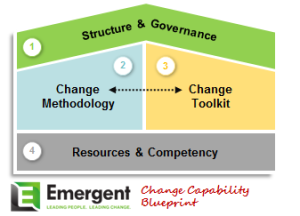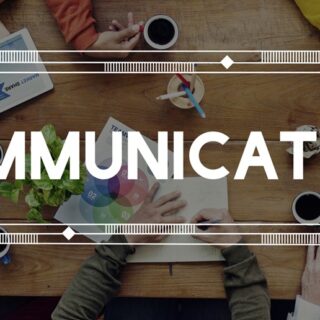
Everyone has heard the statistic. Two-thirds of all change initiatives fail to achieve their expected business benefits – a statistic that has stayed constant from the 1970s to the present. This failure rate represents billions of dollars in lost productivity, wasted resources, opportunity costs and rework—not to mention the negative impact on organizational morale and workforce engagement.
One might conclude that everything we know about change management is wrong and that we need to go back to the drawing board. Instead, we believe that the discipline of change management is reasonably correct, but the capacity to implement change effectively hasn’t been fully developed in organizations.
Organizations that invest in an internal change management capability set themselves apart from their peers. They are able to adapt to the constantly changing business environment more easily, adopt solutions more quickly, and realize project ROI sooner. Ultimately, it gives those organizations a competitive advantage.
So, who needs an internal change management capability? Organizations over a certain size that continuously manage a portfolio of multiple, overlapping change initiatives are candidates for an internal change management capability.
The organizations that benefit most from an internal change management capability typically display a number of symptoms: a proliferation of change management methodologies and tools; change expertise fragmented across functional areas; under-resourced strategic initiatives; and multiple projects that lack a coordinated effort. These symptoms result in the ineffective application of change management and redundant activities, such as multiple communications and potentially confusing engagement initiatives with overlapping stakeholders.
The Capability Design Process
Most often the change management capability is created within IT, HR, or a project management organization. The right design will vary depending on the needs of your organization. We recommend using a contextual-driven design where a number of factors are considered in determining the optimal capability operating model:
- Organization size – the number of people in your extended organization (including employees, contractors, customers, external partners)
- Geographic distribution – the location of your people (centralized or spread across multiple places, national versus international, remote workers)
- Project Pipeline – the number and scope of strategic initiatives undertaken by the organization in a given period of time
- Domain complexity – the inherent sophistication and complexity of your business operations (engineering, manufacturing, store operations, professional services)
- Structure – the current organization and management structure (flat versus hierarchical, collaborative versus command and control, matrix)
 Culture – the organization’s values, visions, social norms, working language, systems (current ability to handle and absorb change)
Culture – the organization’s values, visions, social norms, working language, systems (current ability to handle and absorb change)
With a clear understanding of these factors, the design of the change capability can be tailored specifically for the organization’s unique characteristics. Emergent’s change capability blueprint focuses on four building blocks: Structure & Governance, Methodology, Tools, and Resources & Competency.
Structure & Governance
This critical foundational step focuses on setting the overall operating model. It defines the structure, where it will reside within the organization, and who will be accountable for it. During this activity, we address the following questions: Does the capability serve the entire enterprise or does it focus on a particular business unit? In some cases, companies may find it helpful to distribute change expertise across multiple business units. In other cases, a global and centralized change management “center of excellence” may be better. The step includes designing the roles and team structure required to support the capability. Ultimately, the overall effectiveness depends on choosing an operating model that is the best fit for the organization.
Change Methodology
This activity defines the change management process that will be used. This may be an off-the-shelf methodology such as Kotter’s Eight Steps or Prosci’s ADKAR model, or even a homegrown approach. Often, organizations opt for a hybrid or customized methodology since it can be highly tailored to fit the unique characteristics of the organization. The methodology should address the “intake process” – how to assess change opportunities and resource them appropriately, as well as the “engagement model” – how to work with project teams, executive sponsors, and partners in other functional areas (e.g., HR, OD/Learning & Development, Communications, etc.). Most importantly, this activity should define the set of service offerings that the change management capability has to offer its business customers.
Change Tools
This step focuses on developing a common set of change management tools that map to the change methodology phases. Key decisions here include: Which tools to deploy? How many tools should we have? What format should they be in? The tools should have a common look and feel reflective of the organization’s brand. Ideally, they’ll be stored in an online repository that can be easily-accessed by team members. The tools can be homegrown or the organization can leverage an off-the-shelf toolkit, such as Change Accelerator (www.ChangeAccelerator.com), which can be deployed across the enterprise and customized to the unique needs of the business.
Resources & Competency
This step addresses who will fill the change practitioner roles that were designed previously. Do the requisite knowledge, skills, and abilities reside internally or do you need to hire externally? To what extent you plan to supplement with external consultants?
This activity also involves educatingyour change practitioners, partners, and business customers about the change management operating model, services, and methodology. We recommend segmenting your organization’s key stakeholders based on the level of change management competency required.
For example, senior leaders and middle managers should be aware of the change methodology and their roles as sponsors and change agents, respectively. The organization’s program and project managers should receive a deeper dive into the methodology with an emphasis on partnering with the change management practitioners. The change management practitioners themselves should receive in-depth training, focused on how to use the methodology, deploy the tools, and effectively partner with the projects teams and sponsors.
Learn More
>> Download Emergent’s Blueprint for Building an Internal Change Management Capability, authored by Managing Principal Jesse Jacoby.
Additionally, watch the video overview of Change Accelerator:












5 comments
Pingback: Blueprint For Building An Internal Change Manag...
Pingback: Blueprint for Building an Internal Change Manag...
Jesse Jacoby
at 8:35 am
Thanks for the link back!
Pingback: Blueprint for Building an Internal Change Manag...
Pingback: Blueprint for Building an Internal Change Manag...